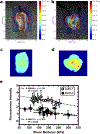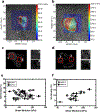Elastography Can Map the Local Inverse Relationship between Shear Modulus and Drug Delivery within the Pancreatic Ductal Adenocarcinoma Microenvironment
- PMID: 30352906
- PMCID: PMC6445768
- DOI: 10.1158/1078-0432.CCR-18-2684
Elastography Can Map the Local Inverse Relationship between Shear Modulus and Drug Delivery within the Pancreatic Ductal Adenocarcinoma Microenvironment
Abstract
Purpose: High tissue pressure prevents chemotherapeutics from reaching the core of pancreatic tumors. Therefore, targeted therapies have been developed to reduce this pressure. While point probes have shown the effectiveness of these pressure-reducing therapies via single-location estimates, ultrasound elastography is now widely available as an imaging technique to provide real-time spatial maps of shear modulus (tissue stiffness). However, the relationship between shear modulus and the underlying tumor microenvironmental causes of high tissue pressure has not been investigated. In this work, elastography was used to investigate how shear modulus influences drug delivery in situ, and how it correlates with collagen density, hyaluronic acid content, and patent vessel density-features of the tumor microenvironment known to influence tissue pressure.
Experimental design: Intravenous injection of verteporfin, an approved human fluorescent drug, was used in two pancreatic cancer xenograft models [AsPC-1 (n = 25) and BxPC-3 (n = 25)].
Results: Fluorescence intensity was higher in AsPC-1 tumors than in BxPC-3 tumors (P < 0.0001). Comparing drug uptake images and shear wave elastographic images with histologic images revealed that: (i) drug delivery and shear modulus were inversely related, (ii) shear modulus increased linearly with increasing collagen density, and (iii) shear modulus was marginally correlated with the local assessment of hyaluronic acid content.
Conclusions: These results demonstrate that elastography could guide targeted therapy and/or identify patients with highly elevated tissue pressure.See related commentary by Nia et al., p. 2024.
©2018 American Association for Cancer Research.
Conflict of interest statement
Figures





Comment in
-
Mapping Physical Tumor Microenvironment and Drug Delivery.Clin Cancer Res. 2019 Apr 1;25(7):2024-2026. doi: 10.1158/1078-0432.CCR-18-3724. Epub 2019 Jan 10. Clin Cancer Res. 2019. PMID: 30630829 Free PMC article.
Similar articles
-
Elastographic Assessment of Xenograft Pancreatic Tumors.Ultrasound Med Biol. 2017 Dec;43(12):2891-2903. doi: 10.1016/j.ultrasmedbio.2017.08.008. Epub 2017 Sep 28. Ultrasound Med Biol. 2017. PMID: 28964615 Free PMC article.
-
Technical Note: In vivo Young's modulus mapping of pancreatic ductal adenocarcinoma during HIFU ablation using harmonic motion elastography (HME).Med Phys. 2018 Nov;45(11):5244-5250. doi: 10.1002/mp.13170. Epub 2018 Oct 1. Med Phys. 2018. PMID: 30178474 Free PMC article.
-
High-Resolution Ex Vivo Elastography to Characterize Tumor Stromal Heterogeneity In Situ in Pancreatic Adenocarcinoma.IEEE Trans Biomed Eng. 2020 Sep;67(9):2490-2496. doi: 10.1109/TBME.2019.2963562. Epub 2020 Jan 1. IEEE Trans Biomed Eng. 2020. PMID: 31902753 Free PMC article.
-
[New Diagnostic Imaging Technique - Shear Wave Elastography].Cesk Slov Oftalmol. 2016 Fall;72(4):103-110. Cesk Slov Oftalmol. 2016. PMID: 27860475 Review. Czech.
-
Elastography for the pancreas: Current status and future perspective.World J Gastroenterol. 2016 Apr 14;22(14):3712-24. doi: 10.3748/wjg.v22.i14.3712. World J Gastroenterol. 2016. PMID: 27076756 Free PMC article. Review.
Cited by
-
Shear Wave Elastography Can Differentiate between Radiation-Responsive and Non-responsive Pancreatic Tumors: An ex Vivo Study with Murine Models.Ultrasound Med Biol. 2020 Feb;46(2):393-404. doi: 10.1016/j.ultrasmedbio.2019.10.005. Epub 2019 Nov 11. Ultrasound Med Biol. 2020. PMID: 31727378 Free PMC article.
-
Imaging methods to evaluate tumor microenvironment factors affecting nanoparticle drug delivery and antitumor response.Cancer Drug Resist. 2021;4(2):382-413. doi: 10.20517/cdr.2020.94. Epub 2021 Jun 19. Cancer Drug Resist. 2021. PMID: 34796317 Free PMC article.
-
Development and validation of a collagen signature to predict the prognosis of patients with stage II/III colorectal cancer.iScience. 2023 Apr 25;26(5):106746. doi: 10.1016/j.isci.2023.106746. eCollection 2023 May 19. iScience. 2023. PMID: 37216096 Free PMC article.
-
Shear wave elastography can stratify rectal cancer response to short-course radiation therapy.Sci Rep. 2023 Sep 26;13(1):16149. doi: 10.1038/s41598-023-43383-5. Sci Rep. 2023. PMID: 37752156 Free PMC article.
-
Recent advances in optical elastography and emerging opportunities in the basic sciences and translational medicine [Invited].Biomed Opt Express. 2022 Dec 16;14(1):208-248. doi: 10.1364/BOE.468932. eCollection 2023 Jan 1. Biomed Opt Express. 2022. PMID: 36698669 Free PMC article. Review.
References
MeSH terms
Grants and funding
LinkOut - more resources
Full Text Sources
Other Literature Sources
Medical

